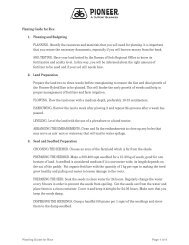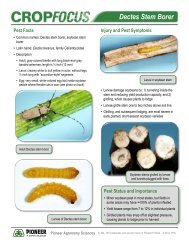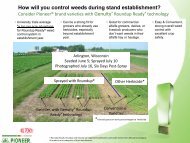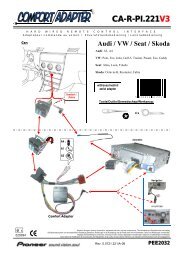Corn Work Shop Book - Pioneer
Corn Work Shop Book - Pioneer
Corn Work Shop Book - Pioneer
Create successful ePaper yourself
Turn your PDF publications into a flip-book with our unique Google optimized e-Paper software.
sugars in grass are stored as cellulose whereas the<br />
grain in maize silage contains high levels of starch.<br />
Animals that have been fed totally on grass will<br />
have relatively low levels of the starch-digesting<br />
and high levels of the cellulose-digesting bacteria.<br />
Feeding large amounts of maize silage to cattle<br />
that have low levels of starch-digesting bacteria<br />
will result in the inefficient use of the maize grain<br />
resulting in large amounts appearing in the dung. A<br />
slow introduction will allow starch-digesting bacteria<br />
levels to increase and will improve utilisation and<br />
minimise the risk of gastric disturbances.<br />
Animals that have not been fed maize silage<br />
previously may take a few days to acquire a taste<br />
for it. Feeding out large quantities of maize silage in<br />
the first few days may result in wastage.<br />
Daily feeding<br />
Once maize silage has been introduced to the diet,<br />
feed it on a daily basis. No feed will be efficiently<br />
used by an animal if it is being added to and<br />
removed from the diet at frequent intervals.<br />
Do not feed maize silage in advance. The best time<br />
to fill your feedout wagon or bins is immediately<br />
prior to the time that you will feed the silage to your<br />
cows. Once silage is removed from the stack and<br />
loosened, aerobic (air present) spoilage begins.<br />
Heating when silage is exposed to air can be<br />
reduced by using a <strong>Pioneer</strong> ®<br />
brand inoculant<br />
containing L. buchneri such as 11C33. Contact your<br />
local <strong>Pioneer</strong> area manager for more information.<br />
Methods of feeding<br />
Farmers are increasingly using feed pads for maize<br />
silage feeding. Where a feed pad is not available<br />
maize silage can be fed out using a feed-out<br />
wagon. The maize silage can be dumped in piles<br />
(by remaining stationary and allowing the silage to<br />
feed-out), in a line in the centre of the paddock or<br />
against a fence line.<br />
The metabolisable energy content of maize silage<br />
is largely determined by the percentage of grain<br />
present since grain contains 70 percent more<br />
energy than stover (the green part of the plant).<br />
Time of harvest, fermentation quality and feed-out<br />
management will also have an effect on energy<br />
content. Some well fermented, high grain content<br />
maize silages have metabolisable energy levels in<br />
excess of 11.5 MJME /kg DM, i.e. MJ of metabolisable<br />
energy per kg of dry matter.<br />
Buying in maize silage<br />
Purchase price<br />
Maize silage is normally traded on a standing basis<br />
with the purchaser paying for the harvesting and all<br />
subsequent costs. There are two main methods of<br />
purchasing a standing crop.<br />
1. On a per kilogram drymatter basis<br />
In this case the grower and purchaser agree upon<br />
a standing price (cents per kg of dry matter).<br />
Legally, crops that are sold on a weight basis must<br />
be weighed on a 'weights and measures approved'<br />
weigh bridge. Every load of the crop must be weighed<br />
to determine the wet weight. Drymatter samples<br />
are collected throughout the harvest period and<br />
analysed to determine the drymatter percentage.<br />
Crop wet weight (tonnes) x drymatter (percent) =<br />
crop drymatter yield (tonnes)<br />
The advantage of buying a crop on a per kilogram<br />
drymatter basis is that you know exactly how much<br />
you will be paying for each kilogram of drymatter<br />
that you feed. The main disadvantage is that cartage<br />
costs may be increased if trucks need to detour to<br />
be weighed. Care must be taken to ensure that a<br />
representative drymatter sample is collected.<br />
2. On a per hectare basis<br />
The grower and purchaser agree upon a price per<br />
hectare prior to crop harvest time. The actual maize<br />
silage cost (cents per kg of dry matter) will vary<br />
greatly depending on the per hectare price paid<br />
and the crop yield.<br />
When a crop is purchased on a per hectare basis,<br />
the purchaser gains the advantage of a high dry<br />
matter yield and the risk of a poor dry matter yield.<br />
Selling on a per hectare basis means that there is no<br />
requirement to weigh the crop or to take dry matter<br />
samples to determine yield.<br />
Subsequent costs<br />
If a crop is purchased standing the grower is required<br />
to pay for further costs such as harvesting, inoculants,<br />
cartage, stacking, covering.<br />
. Summary<br />
The input most frequently found to be deficient in<br />
low yielding or unprofitable corn crops is grower<br />
management. Every corn grower must learn to set<br />
a yield goal at the start of the season before he<br />
begins planting. Without a yield goal it is impossible<br />
to calculate the correct plant population needed,<br />
the amount of fertiliser required, or whether the<br />
intended crop will be profitable.<br />
<strong>Corn</strong> is a crop that offers farmers the prospect of<br />
good profit margins provided they are prepared to -<br />
1. Understand the requirements of the crop<br />
2. Plant suitable hybrids at the correct plant<br />
population<br />
3. Provide adequate fertiliser inputs<br />
4. Supply the crop with water at the critical growth<br />
stages<br />
5. Only grow a manageable area<br />
• Timeliness is an essential element of corn crop<br />
management, and most corn crop failures, can<br />
be traced back to poor timing of inputs or<br />
farming operations associated with that crop.<br />
40 4<br />
• Early preparation is another important element<br />
of successful corn crops, including ground<br />
preparation, fertiliser and water application to<br />
ensure yield is not lost.<br />
• Early planting usually gives the highest yields<br />
in any area each year because of the longer<br />
growing period available to accumulate sugars<br />
and starches in early spring.<br />
• A combination of early planting is almost always<br />
involved in all high-yielding crops produced by<br />
Australia's leading corn growers.<br />
• <strong>Corn</strong> is a crop that responds to good management,<br />
so time and effort spent learning how to grow and<br />
manager the crop will result in improved yields<br />
and profitability.<br />
It is hoped that the information provided by <strong>Pioneer</strong><br />
Hi-Bred Australia in this booklet will assist our farmer<br />
customers to become better and more profitable<br />
corn growers.








